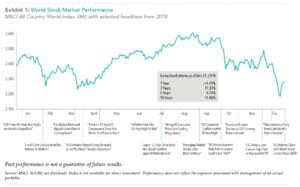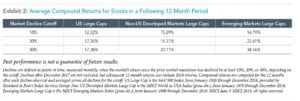2018 marked a generally negative year for global equity markets. Despite positive returns experienced in the first 3 quarters of the year the final quarter saw major global indices turn down, largely as a result of fears of trade disputes between US and China.
The fourth quarter equity market decline has many investors wondering how equities may perform in the near term.
Equity market declines of 10% have occurred numerous times in the past.
In 2018 the S&P 500 index (US) returned –11.5% in the fourth quarter while the MSCI All Country World Index returned –10.7%.
Research by Dimensional Fund Advisors shows after declines of 10% or more, equity returns over the subsequent 12 months have been on average positive 74% of the time in US markets and 78% of the time in other developed markets.[1]

Exhibit 1 highlights some of the year’s prominent headlines in the context of global stock market performance as measured by the MSCI All Country World Index (IMI). These headlines are not offered to explain market returns. Instead, they serve as a reminder that investors should view daily events from a long-term perspective and avoid making investment decisions based solely on the news.
Market Volatility
Exhibit 2 shows the performance of markets subsequent to declines of 10%, 20%, and 30%. For each decline threshold, returns are shown for US large cap, non-US developed markets large cap, and emerging markets large cap stocks in the following 12-month period. While declines in equity markets may cause investor concern, the data provides evidence that markets generally have positive returns after a decline.
The increased market volatility in the fourth quarter of 2018 underscores the importance of following an investment approach based on diversification and discipline rather than prediction and timing. For investors to successfully predict markets, they must forecast future events more accurately than all other market participants and predict how other market participants will react to their forecasted events.
There is little evidence suggesting that either of these objectives can be accomplished on a consistent basis. Instead of attempting to outguess market prices, investors should take comfort that market prices quickly incorporate relevant information and that information will be reflected in expected returns.
While we cannot control markets, we can control how we invest.
[1] Declines are defined as points in time, measured monthly, when the market’s return since the prior market maximum has declined by at least 10%. Declines after December 2017 are not included, but subsequent 12-month returns can include 2018 returns. Compound returns are computed for the 12 months after each decline observed and averaged across all declines for the cut-off. US markets (1926–2018) are represented by the S&P 500 and Developed ex US markets (1970–2018) are represented by the MSCI World ex USA Index.


